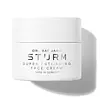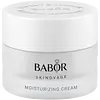What's inside
What's inside
 Key Ingredients
Key Ingredients

 Benefits
Benefits

 Concerns
Concerns

 Ingredients Side-by-side
Ingredients Side-by-side

Water
Skin ConditioningCaprylic/Capric Triglyceride
MaskingDecyl Oleate
EmollientButyrospermum Parkii Butter
Skin ConditioningGlycerin
HumectantHydrogenated Lecithin
EmulsifyingPentylene Glycol
Skin ConditioningLactobacillus/Portulaca Oleracea Ferment Extract
AntioxidantOlea Europaea Fruit Oil
MaskingPersea Gratissima Oil
Skin ConditioningTocopheryl Acetate
AntioxidantCeramide NP
Skin ConditioningSodium Hyaluronate
HumectantPolygonum Bistorta Root Extract
Skin ConditioningLeuconostoc/Radish Root Ferment Filtrate
AntimicrobialPlankton Extract
Skin ConditioningPhenoxyethanol
PreservativePanthenol
Skin ConditioningC12-16 Alcohols
EmollientPalmitic Acid
EmollientSqualane
EmollientXanthan Gum
EmulsifyingCarbomer
Emulsion StabilisingEthylhexylglycerin
Skin ConditioningHelianthus Annuus Seed Oil
EmollientTocopherol
AntioxidantTeprenone
Skin ConditioningSodium Hydroxide
BufferingHexylene Glycol
EmulsifyingPantolactone
HumectantCaprylyl Glycol
EmollientCitric Acid
BufferingWater, Caprylic/Capric Triglyceride, Decyl Oleate, Butyrospermum Parkii Butter, Glycerin, Hydrogenated Lecithin, Pentylene Glycol, Lactobacillus/Portulaca Oleracea Ferment Extract, Olea Europaea Fruit Oil, Persea Gratissima Oil, Tocopheryl Acetate, Ceramide NP, Sodium Hyaluronate, Polygonum Bistorta Root Extract, Leuconostoc/Radish Root Ferment Filtrate, Plankton Extract, Phenoxyethanol, Panthenol, C12-16 Alcohols, Palmitic Acid, Squalane, Xanthan Gum, Carbomer, Ethylhexylglycerin, Helianthus Annuus Seed Oil, Tocopherol, Teprenone, Sodium Hydroxide, Hexylene Glycol, Pantolactone, Caprylyl Glycol, Citric Acid
Water
Skin ConditioningDecyl Oleate
EmollientButylene Glycol
HumectantSteareth-2
EmulsifyingOctyldodecanol
EmollientSesamum Indicum Seed Oil
EmollientCetearyl Alcohol
EmollientGlycerin
HumectantButyrospermum Parkii Butter
Skin ConditioningSteareth-21
CleansingSorbitol
HumectantLimnanthes Alba Seed Oil
Skin ConditioningBrassica Campestris Sterols
EmollientPhenoxyethanol
PreservativePanthenol
Skin ConditioningDimethicone
EmollientBeta Vulgaris Root Extract
Skin ConditioningHydrolyzed Corn Starch
HumectantTocopheryl Acetate
AntioxidantCarbomer
Emulsion StabilisingSodium Cetearyl Sulfate
CleansingLimonene
PerfumingSodium Hydroxide
BufferingParfum
MaskingEthylhexylglycerin
Skin ConditioningSodium Hyaluronate
HumectantLactic Acid
BufferingDisodium EDTA
Hydrogenated Lecithin
EmulsifyingAlcohol
AntimicrobialPhenethyl Alcohol
MaskingCaprylic/Capric Triglyceride
MaskingLinalool
PerfumingPantolactone
HumectantP-Anisic Acid
MaskingCitral
PerfumingAscorbyl Palmitate
AntioxidantCitric Acid
BufferingMaltodextrin
AbsorbentAscorbic Acid
AntioxidantHydrolyzed Royal Jelly Protein
Skin ConditioningWater, Decyl Oleate, Butylene Glycol, Steareth-2, Octyldodecanol, Sesamum Indicum Seed Oil, Cetearyl Alcohol, Glycerin, Butyrospermum Parkii Butter, Steareth-21, Sorbitol, Limnanthes Alba Seed Oil, Brassica Campestris Sterols, Phenoxyethanol, Panthenol, Dimethicone, Beta Vulgaris Root Extract, Hydrolyzed Corn Starch, Tocopheryl Acetate, Carbomer, Sodium Cetearyl Sulfate, Limonene, Sodium Hydroxide, Parfum, Ethylhexylglycerin, Sodium Hyaluronate, Lactic Acid, Disodium EDTA, Hydrogenated Lecithin, Alcohol, Phenethyl Alcohol, Caprylic/Capric Triglyceride, Linalool, Pantolactone, P-Anisic Acid, Citral, Ascorbyl Palmitate, Citric Acid, Maltodextrin, Ascorbic Acid, Hydrolyzed Royal Jelly Protein
Ingredients Explained
These ingredients are found in both products.
Ingredients higher up in an ingredient list are typically present in a larger amount.
This ingredient is also known as shea butter. It is an effective skin hydrator and emollient.
Emollients help soothe and soften your skin. It does this by creating a protective film on your skin. This barrier helps trap moisture and keeps your skin hydrated. Emollients may be effective at treating dry or itchy skin.
Shea butter is rich in antioxidants. Antioxidants help fight free-radicals, or molecules that may harm the body. It is also full of fatty acids including stearic acid and linoleic acid. These acids help replenish the skin and keep skin moisturized.
While Shea Butter has an SPF rating of about 3-4, it is not a sunscreen replacement.
Shea butter may not be fungal acne safe. We recommend speaking with a professional if you have any concerns.
Learn more about Butyrospermum Parkii ButterThis ingredient is an emollient, solvent, and texture enhancer. It is considered a skin-softener by helping the skin prevent moisture loss.
It helps thicken a product's formula and makes it easier to spread by dissolving clumping compounds.
Caprylic Triglyceride is made by combining glycerin with coconut oil, forming a clear liquid.
While there is an assumption Caprylic Triglyceride can clog pores due to it being derived from coconut oil, there is no research supporting this.
Learn more about Caprylic/Capric TriglycerideCarbomer is a polymer of acrylic acid. Its main role is to create a gel consistency.
A high amount of carbomer can cause pilling or balling up of products. Don't worry, most products contain 1% or less of carbomer.
Citric Acid is an alpha hydroxy acid (AHA) naturally found in citrus fruits like oranges, lemons, and limes.
Like other AHAs, citric acid can exfoliate skin by breaking down the bonds that hold dead skin cells together. This helps reveal smoother and brighter skin underneath.
However, this exfoliating effect only happens at high concentrations (20%) which can be hard to find in cosmetic products.
Due to this, citric acid is usually included in small amounts as a pH adjuster. This helps keep products slightly more acidic and compatible with skin's natural pH.
In skincare formulas, citric acid can:
While it can provide some skin benefits, research shows lactic acid and glycolic acid are generally more effective and less irritating exfoliants.
Most citric acid used in skincare today is made by fermenting sugars (usually from molasses). This synthetic version is identical to the natural citrus form but easier to stabilize and use in formulations.
Read more about some other popular AHA's here:
Learn more about Citric AcidDecyl Oleate comes from decyl alcohol and oleic acid.
Decyl Oleate is an emollient. It helps moisturize the skin by creating a thin barrier on top to prevent moisture from escaping.
This ingredient may not be fungal-acne safe.
Learn more about Decyl OleateEthylhexylglycerin (we can't pronounce this either) is commonly used as a preservative and skin softener. It is derived from glyceryl.
You might see Ethylhexylglycerin often paired with other preservatives such as phenoxyethanol. Ethylhexylglycerin has been found to increase the effectiveness of these other preservatives.
Glycerin is already naturally found in your skin. It helps moisturize and protect your skin.
A study from 2016 found glycerin to be more effective as a humectant than AHAs and hyaluronic acid.
As a humectant, it helps the skin stay hydrated by pulling moisture to your skin. The low molecular weight of glycerin allows it to pull moisture into the deeper layers of your skin.
Hydrated skin improves your skin barrier; Your skin barrier helps protect against irritants and bacteria.
Glycerin has also been found to have antimicrobial and antiviral properties. Due to these properties, glycerin is often used in wound and burn treatments.
In cosmetics, glycerin is usually derived from plants such as soybean or palm. However, it can also be sourced from animals, such as tallow or animal fat.
This ingredient is organic, colorless, odorless, and non-toxic.
Glycerin is the name for this ingredient in American English. British English uses Glycerol/Glycerine.
Learn more about GlycerinHydrogenated Lecithin is created from the hydrogenation of lecithin (a group of phospholipids). Hydrogenation is a chemical reaction between hydrogen and another element.
This ingredient is an emollient and emulsifier. As an emollient, it helps soften skin by trapping moisture within. As an emulsifier, it prevents oil and water ingredients from separating.
Panthenol is a common ingredient that helps hydrate and soothe the skin. It is found naturally in our skin and hair.
There are two forms of panthenol: D and L.
D-panthenol is also known as dexpanthenol. Most cosmetics use dexpanthenol or a mixture of D and L-panthenol.
Panthenol is famous due to its ability to go deeper into the skin's layers. Using this ingredient has numerous pros (and no cons):
Like hyaluronic acid, panthenol is a humectant. Humectants are able to bind and hold large amounts of water to keep skin hydrated.
This ingredient works well for wound healing. It works by increasing tissue in the wound and helps close open wounds.
Once oxidized, panthenol converts to pantothenic acid. Panthothenic acid is found in all living cells.
This ingredient is also referred to as pro-vitamin B5.
Learn more about PanthenolPantolactone is a synthetically created humectant.
As a humectant, Pantolactone helps draw moisture to the skin. It can help add hydration to your skin.
Phenoxyethanol is a preservative that has germicide, antimicrobial, and aromatic properties. Studies show that phenoxyethanol can prevent microbial growth. By itself, it has a scent that is similar to that of a rose.
It's often used in formulations along with Caprylyl Glycol to preserve the shelf life of products.
Sodium Hyaluronate is hyaluronic acid's salt form. It is commonly derived from the sodium salt of hyaluronic acid.
Like hyaluronic acid, it is great at holding water and acts as a humectant. This makes it a great skin hydrating ingredient.
Sodium Hyaluronate is naturally occurring in our bodies and is mostly found in eye fluid and joints.
These are some other common types of Hyaluronic Acid:
Learn more about Sodium HyaluronateSodium Hydroxide is also known as lye or caustic soda. It is used to adjust the pH of products; many ingredients require a specific pH to be effective.
In small amounts, sodium hydroxide is considered safe to use. However, large amounts may cause chemical burns due to its high alkaline.
Your skin has a natural pH and acid mantle. This acid mantle helps prevent harmful bacteria from breaking through. The acid mantle also helps keep your skin hydrated.
"Alkaline" refers to a high pH level. A low pH level would be considered acidic.
Learn more about Sodium HydroxideTocopheryl Acetate is AKA Vitamin E. It is an antioxidant and protects your skin from free radicals. Free radicals damage the skin by breaking down collagen.
One study found using Tocopheryl Acetate with Vitamin C decreased the number of sunburned cells.
Tocopheryl Acetate is commonly found in both skincare and dietary supplements.
Learn more about Tocopheryl AcetateWater. It's the most common cosmetic ingredient of all. You'll usually see it at the top of ingredient lists, meaning that it makes up the largest part of the product.
So why is it so popular? Water most often acts as a solvent - this means that it helps dissolve other ingredients into the formulation.
You'll also recognize water as that liquid we all need to stay alive. If you see this, drink a glass of water. Stay hydrated!
Learn more about Water